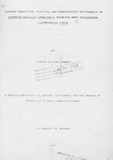| dc.contributor.author | Joseph NM | |
| dc.date.accessioned | 2013-05-23T07:24:46Z | |
| dc.date.issued | 1988 | |
| dc.identifier.uri | http://erepository.uonbi.ac.ke:8080/xmlui/handle/123456789/24636 | |
| dc.description | MSc | en |
| dc.description.abstract | A study was carried out to determine the effect of
Trypanoso a (Duttonella) vivax Ziemann infection in Glossina
palpalis gambiensis Vanderplank on the survival and reproductive performance.
feeding behaviour,
A colony of this subspecies was maintained in the laboratory: results showed
that the performance of the flies in terms of female survival
and fecundity and weight of puparia produced was consistently
good stock
Teneral male and female flies infected with T. vivax
ILRAD 3145 were compared with untnfected controls by
measuring the following parameters: {l} mean number of feeds
in 20 consecutive days; (2) mean rate of bloodmeal intake
ug/sec. of the total days fed; (3)mean wei~hL of bloodmeal
intake/day of the total days fed; (4)mean total bloodmeal
engorgement in 20 days; (5)mean number of probes/day of the
days fed; (6) mean frequency of the multiple probe feeds.
(7 ) mean number of pre-feeding probes of the multiple and
probe feeds. There were no significant differences 1
feeding between the infected and the uninfected controls.
The results suggested that the presence of T. Vivax
epimastigotes in the labrum had no deleterious effect on the
feeding behaviour of the tsetse vectors.
The frequency of probing during feeding by hungry tsetse
flies in relation to transmission of T. vivax was also
studied. The infected tsetse flies were 80J allowed to probe consecutively without feedin~ on two gats and then
allowed to complete feeding on a third one, and the rate of
transmission calculated. Evidence was found to suggest that
infected flies transmitted trypanosomes both during probing
and when they completed feeding on the susceptible hosts.
The survival and reproductive performance of the infected and
the uninfected flies were compared by recording daily
mortality and pupal production of a group of 100 infected
females and 88 infected males and an equal number of
uninfected controls. Results suggested that the presence of
trypanosomes in the mouthpart had no adverse effect on the
survival of the flies. The weights of pupae produced were
also not affected. suggesting that reproductive
physiology of the female and the nutrition of the pregnant
females in relation to nourishment of the intra- uterine larvae was not affected by infection of the flies with T. vivax. | en |
| dc.language.iso | en | en |
| dc.subject | Glossina palpalis | en |
| dc.subject | Feeding behaviour | en |
| dc.title | Feeding behaviour, survival and reproductive performance of glossina palpalis gambiensis infected with trypanosome (puttonella) vivax | en |
| dc.type | Thesis | en |
| local.publisher | FAculty of Agriculture, University of Nairobi | en |

